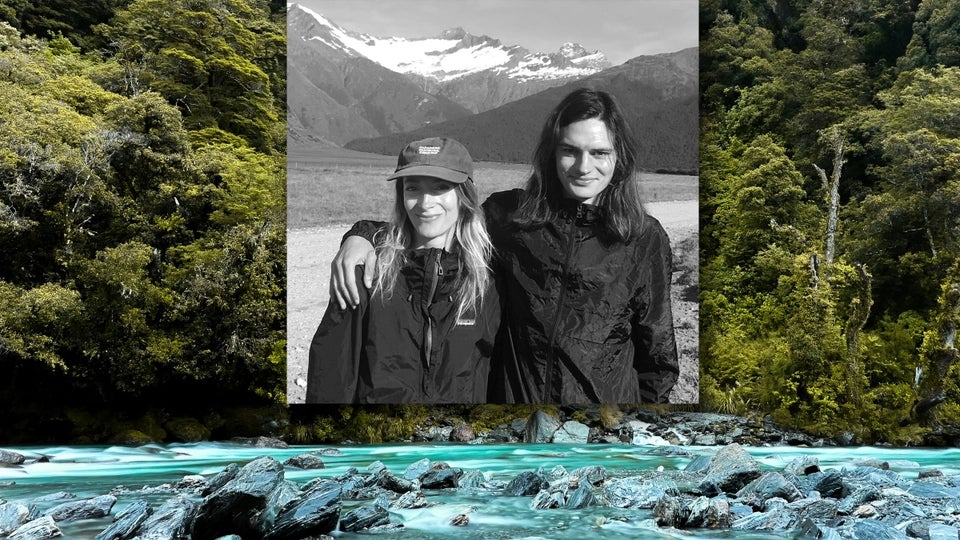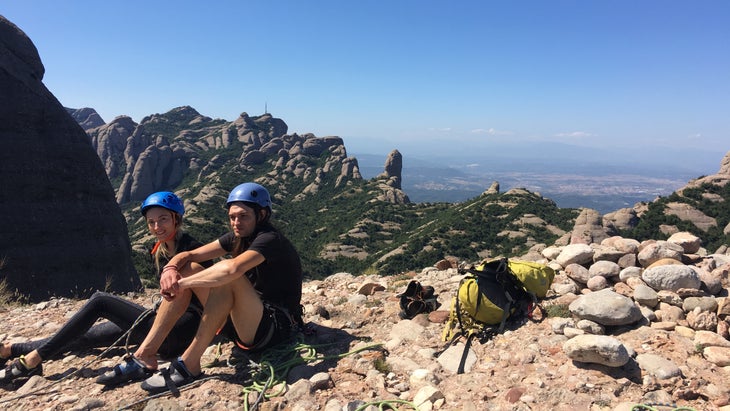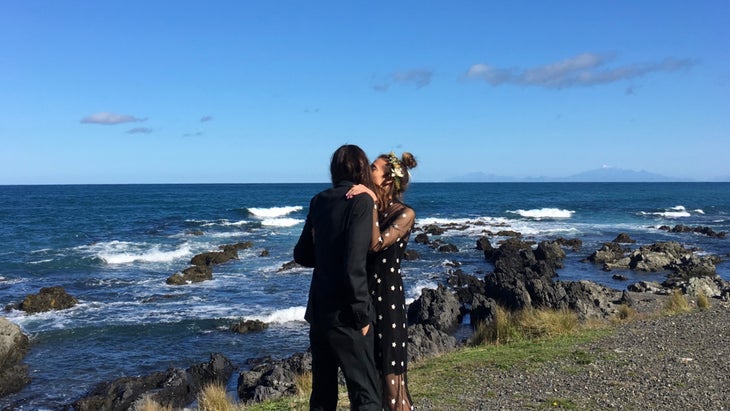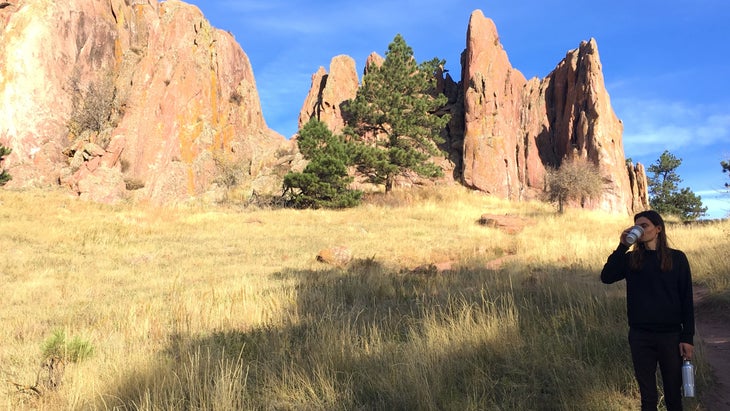I Thought My Love for Climbing Died with My Husband. I Was Wrong.

What do you do with someone’s climbing shoes when they die? I hadn’t thought about it. After all, my husband, Cam, was 34 and still should have had many years of climbing ahead of him. It was December 2019, the season of gift-giving, as I sat in our apartment shedding his belongings. Some things felt fitting to donate (a ski jacket) or use (a laptop), but his climbing shoes were a problem. We’d purchased them together in 2017 at The Arch climbing gym in London—a pair of his and hers Scarpas. We downsized to increase precision on footholds, and our feet would come out of them sore and imprinted, the tiny shoes warm and sweaty. They were molded to our feet by some of the best times of our lives and carried these memories like ghosts. In the summer of 2018, we wore our shoes in Spain’s Catalonian mountains. On the shoe rack, they sat as a reminder of the future I had imagined we’d have. Too intimate to give away and too painful to keep, I wrapped them in newspaper and put them in the garbage outside. Then I came back to our apartment and hid my pair in the hallway cupboard.
Cam and I met in our early twenties, while I was studying abroad in his hometown, Wellington, New Zealand. After two years together, we moved to London, where I found a series of gigs in media. One of my jobs was at a photography gallery that hosted an exhibition of mountaineer Bradford Washburn’s work. I was fascinated by the tiny dots of climbers on the great peaks. The vast landscapes contrasted the crowded city outside the gallery windows, the climbers’ quiet focus the opposite of my busy life. I booked my first climbing lesson at a local gym, encouraging Cam to come along the following week. We were quickly hooked on the sport’s combination of physical exertion and problem-solving. After years of climbing indoors, we used our savings to move to Spain in 2018, where we would be closer to mountains.

We didn’t have a car in Barcelona, so we walked almost everywhere. One time we caught a train to a village we had read was a starting point for trails into the mountains and, unsure where to go, went to the local police station. The officer on duty happened to be a hiker and, between our rough Spanish and his better English, managed to give us directions to an area with perfect pinnacles of conglomerate rock. It became our favorite climbing spot. Sometimes on the way back home, we stopped at a medieval chapel nestled at the base of the mountains to rest. I’ve never prayed, but I remember sitting in a pew and being thankful to something, as if our adventurous life was too good to be by chance.
After our summer in Spain, Cam was offered a job as a graphic designer at a film studio in New Zealand. We moved on New Year’s Day in 2019. Life fell into a new rhythm. We found a new climbing gym and a coffee shop to fuel up on Americanos before we climbed. Then, coffee started making Cam feel nauseous. He hadn’t been at his job long before he was bringing home half-eaten lunch boxes and soon, wasn’t eating much at all. I persuaded him to go for pizza one evening, even though he was exhausted. On the way home after dinner, he threw up in a public bin, angling his head like a chicken so he didn’t miss the liner.
The Friday before Easter that year, we went for a walk in the forest. I thought the fresh air would be good for his stubborn cough, but he had to keep leaning on tree stumps to catch his breath. That Sunday, a couple of months after he’d started feeling off, he collapsed in the shower. When I found him curled up on the bathroom floor, he was thinner than I had realized or chosen to see. We went to the emergency room, where scans showed shadows that the doctors said were likely tumors across his lungs. A week later, an oncologist confirmed the diagnosis: Cam had advanced gallbladder cancer, and treatment may give him a year, “if he was lucky.”

Chemotherapy stabilized things a little at first, allowing Cam to work at the film studio a couple of days a week. We decided to get married at Red Rocks, a rugged coastal area named for its distinctive geology. By then, we’d been together for seven years. We offered a ride to some German backpackers who were hiking a route we’d done just a few months before. After we dropped them off, I watched them gleefully walk away in the rearview mirror. They had their whole lives ahead of them, I guess.
After a couple of months, the chemotherapy couldn’t hold back the cancer anymore. Cam switched to another treatment that gave him constant pins and needles in his hands. A PICC line was fitted this time—a tube that threaded through a vein in his arm to his heart. His arms, which had once moved up mountains, were stringy and bandaged, and his shoulder throbbed from cancer eroding his bone. Still, from our couch and then from his hospital bed, he encouraged me to keep climbing. At times, I considered it. Perhaps I could photograph boulder problems and we’d map them out together at home. As if that would be enough. As if I wouldn’t feel like some kind of fraud for being there without him, or guilty for climbing a wall when he needed to hold me just to get out of a chair. I didn’t go. As Cam grew sicker, climbing became irrelevant. There were so many days in the ER I thought would be his last—a bout of the flu, a suspected blood clot, pancreatitis. Instead, the final days passed quietly as he got a little bit weaker and further away.
Our once-adventurous life together ended in a stuffy hospice room. I decorated the walls with photographs of the beautiful places we’d been, as if what we’d done could offset how much was being lost. There was a photo Cam took of El Capitan when we’d been in Yosemite the year before. We had met the climber Brad Gobright in a cafe, and he told us we could keep our coffee cups for free refills. We clung on to them and by the second morning, the bottom of Cam’s cup was bowing so much, I worried he’d get burnt. I hadn’t worried we’d get hurt climbing. That was something that happened to other people who made mistakes I told myself we wouldn’t make. But the reality is that good decision-making can’t protect you from all terrible things. You can treat your body like a temple and still get cancer.
In the evenings, I’d slip around the back of the hospice building, the night air a sliver of the great outdoors. Sitting on the cool concrete steps one evening, I saw a headline on my phone that said Brad had died in a climbing accident. I hurried back inside to tell Cam. I shook his bony shoulder, his eyelids drooping, an unfixed gaze across the room. I told him again and again, but he never responded. He never regained consciousness and died two days later, slipping away quietly just after midnight as I slept next to him, on December 5, 2019.

What do you do when the person you share a hobby with dies? Do you keep doing it? Perhaps if we ran together, I would grieve and move forward on the trail alone. Instead, we’d chosen a sport that requires a rope with a person at either end. It’s a game for two—auto belays, bouldering, and soloing aside. Cam and I had bounced between countries and gyms, never rooting ourselves in a climbing community, naively thinking we would always have each other to climb with. I tried to convince myself that I didn’t even want to climb anymore. I unfollowed climbers on social media, stayed on flat land, and threw out climbing with Cam’s Scarpas.
We’d chosen a sport that requires a rope with a person at either end. It’s a game for two—auto belays, bouldering, and soloing aside.
In the New Year, I had an appointment with a psychiatrist at the same hospital where Cam was a patient. In an effort to help me feel less alone, he shared that his childhood neighbor died in a swimming pool, and he could still picture them every time he smelled chlorine. I asked whether a drowned person sinks or floats (they tend to sink first and then float, it turns out). Perhaps it was because of questions like that, the fact that I was hardly eating, or my mention that I still had a small pharmacy of Cam’s pain medications, that he referred me to a mental health respite facility.
That evening, a nurse drove me to what looked like an average suburban home. Inside, there weren’t any locks on the doors. Someone checked in on me every hour to make sure I hadn’t climbed out the window. In the morning, I propped myself by the windows overlooking the waking city. There were kayaks on the harbor and I could see the film studios where Cam had worked. I learned from Cam’s colleague that he had persisted with climbing several flights of stairs to his office, even when he was frail and his feet were so swollen with fluid that he couldn’t tie his shoes. When there was nothing else to summit, he summited the stairs. To my left, I could see our old climbing gym. Cam would do anything to be there now, I thought. He hadn’t given up climbing—cancer had taken it from him. I could still honor what we had created together. I told one of the nurses I’d feel better getting some exercise, checked myself out, and went where I needed to be.
It had been a year since I had chalked up my hands. I entered the gym and made my way past the roped climbing walls to the bouldering area at the back—the territory of the solo climber. I sat on the edge of a mat and shimmied my shoes on, my toes curled and ready to climb. Black holds—beginner’s routes. As soon as I pushed off, I could feel the weight of my grief. Months of broken sleep and erratic eating had changed my body. I found that even an easy route requires focus. Without the distraction of ropes or the noise of anyone else, it’s purely about where you put your hands and feet. Thoughts of Cam consumed me night and day. But ironically, when I climbed, I didn’t think about him much at all. So I kept climbing, route after route.

The second session was the humbling one, where I realized I had a newfound fear of heights. I’ve seen ambulances called after people took bad falls. Once, I saw someone land so painfully they peed on the crash pad. I wonder if the gym intimidated them and made them feel stiff and brittle, like it does for me now. I used to have the armor of being in a duo, my lover at the base of a route calling out encouragement. After everything I’d been through, my mind was wired to expect the worst-case scenario, so I only climbed halfway up routes to shorten the distance I’d fall.
I entered the gym and made my way past the roped climbing walls to the bouldering area at the back—the territory of the solo climber.
A friend called me last year and told me she had been climbing in Mexico with her new boyfriend. From the photos, it looked like heaven. I was so happy for her, but sometimes I would rather lay face down on a crash pad than act like I’m totally cool bouldering by myself. I miss climbing on warm rocks, the clink of a quickdraw on a bolt, the birds…him. I haven’t climbed outside since Cam died. The landscape of my hobby is different now—a rock wall under a roof. It’s me and me alone, problem-solving, encouraging myself to push a little harder. On a good day, that can feel empowering. In those moments where I doubt myself and my abilities, I remind myself that I was the one who booked that first climbing lesson. As much as Cam was a climber, I am too.
Today, I still live in New Zealand, but I boulder at a different climbing gym, in a different town. I am in a relationship with a man who is many wonderful things, but not a climber. I recently topped out on the hardest problem I’ve ever completed. I’m the strongest I’ve ever been, and no one really knows that but me. Recently, someone approached me at the gym, suggesting I come to a social night where lots of solo climbers partner to belay each other. A few of them climb in the mountains on the weekends. I still don’t know if I’m ready to climb with anyone else, and I haven’t climbed outside in five years. Perhaps someday I will.
This story originally appeared in Outside.
The post I Thought My Love for Climbing Died with My Husband. I Was Wrong. appeared first on Climbing.

